Isabella had suggested going to the top floor of the hotel (restaurant and bar) early in the morning to get a good view and photo of Mt. Etna, since it usually clouds over in the afternoon, so we did.
After breakfast, we headed to the WWII Museum in Catania. The initial part was about the damage of the bombing here in 1943, and in part, it was compared to the German bombing of England and the superior protections they had in the Undergrounds. I found the comparison somewhat unfair given the much shorter time the Italians had to endure it. When Mussolini decided to enter the war on the German side, it looked like the Germans were winning and it would be a quick, easy war with little cost to the Italians and the potential for great gain. Of course that calculation proved to be somewhat off.
The museum showed a typical street, then led us into an air raid bunker and simulated the sounds and sensations of the bombing raid. It exited to an example of a destroyed street. (At this point I discovered photos were taboo, so I stopped shooting.)
 |
Exterior of former sulfur plant built with lava rock that now
houses the WWII museum |
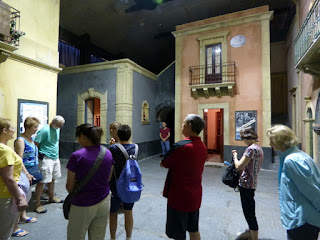 |
Reconstructed street. All the building interiors came from
donations of real period items. |
 |
| Reconstruction of stable with lava rock arch |
 |
| Coming out of the simulated air raid shelter, the simulated damage. |
The rest of the museum took us through the comparative strengths of each
side. They also highlighted the very racist Soldier's Guide to Sicily,
which Jim says was published by the British. It called the Sicilians
dirty, stinky people of loose morals and it was okay for soldiers to
'enjoy' the Sicilian women because their husbands would not object. It
is always interesting hearing the version of events you thought you knew
from the other side's point of view.
One point that was brought up was that Lucky Luciano (mafioso) was critical in helping the Allies with intelligence about Sicily in exchange for a shorter sentence, which we had also heard during the Mafia discussion. This guide added that Lucky was instrumental in recommending people for various government posts after the liberation, who were primarily his associates. The museum is set in a reclaimed sulfur processing plant, which was unable to compete with Canadian producers.
Then we hopped back on the bus and headed for the main square, by way of the fish market, where the Duomo is and also the symbol of Catania, the elephant. When Europe broke away from Africa, apparently there were elephants on Sicily for a while, and because of the limited resources, they were a dwarf variety. (Sicily appears to be on the African plate.) When the Greeks arrived in the 700s BCE and started excavating for their buildings, they discovered the skeletons of elephants and interpreted the skulls that left holes for the trunks as being the skeletons of the Cyclops who they claimed lived on Mt. Etna.
 |
| Original wall around the city. |
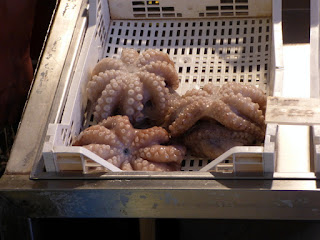 |
| Interesting display of octopi |
 |
| Not sure what kind of fish, but cool to see them coiled. |
 |
| A shrimp variety we had never seen. Seasonally available. |
 |
| Squid |
 |
The elephant. After the 1693 earthquake, if fell
and broke its trunk. When they glued it back on, they
added a random Egyptian obelisk to the top. |
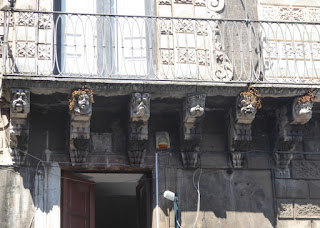 |
| More creative balcony supports |
 |
| The Duomo is more elaborate outside than in. |
 |
Above and below: Islam and Jewish stars at the entry to the
Duomo. Before the Inquisition (1493), all 3 major religions
co-existed peacefully here. |
We went into the Cathedral during a Mass, so our ability to hear our guide was limited. The patron saint of Catania is Agatha, who was a 16 year old in the 300s AD who dedicated her life to Christ. She was from a wealthy family and a local politician wanted to marry her to access to her family's wealth. She said no, he got angry, persecuted her for her religion, she was tortured and they cut off her breasts, and had her burned at the stake. She is also a patron saint for breast cancer patients. There is a local delicacy that Isabella got for us: little green mounds of cake and sugar topped by a cherry that represent her breasts.
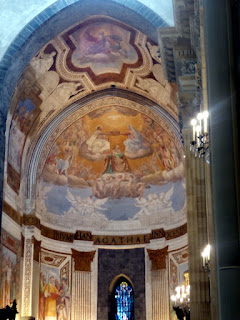 |
| Altar ceiling in the Duomo |
 |
| Bellini, a Catania native, is buried here. |
 |
These are the treats that represent St. Agatha's breasts. VERY
sweet. |
|
We learned that a river used to run through the central square, and that it was set up as a spa so that when sailors came into the city, they paid a fee and that included the spa where they could lose the months of sweat and odors they had accumulated as well as getting a bit of female attention so that they wouldn't be inclined to harass the local women. One of Mt. Etna's eruptions filled most of the spa in with lava, and the remaining bits have only recently been discovered. There was also an area that we drove though that used to be part of the harbor until and eruption pushed the waterfront out 1.5 miles.
 |
This was part of the harbor until an eruption filled it in. The
bridge pre-dates the eruption. |
Isabella took us to restaurant that discovered it has a portion of the river flowing below it and we got to take a look before having a light lunch. We had free time for over an hour and discovered when my camera battery got low that the backup was dead, so we walked back to the hotel to start the charging process before heading back to our meeting point and getting a strawberry gelato to fight the heat.
 |
| Brian at the underground river |
 |
| Looking the other direction. It used to be a bunch bigger. |
We got back on the bus and drove north an hour to Taormina, site of a Greek and Roman Theater. We took a cable car up the hill to the town and met Vera. She told us the town moved up the hill when it was invaded.
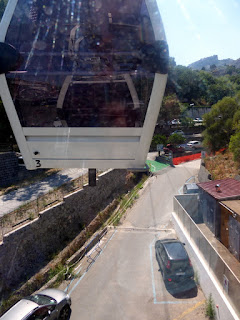 |
| View to the road from our cable car. |
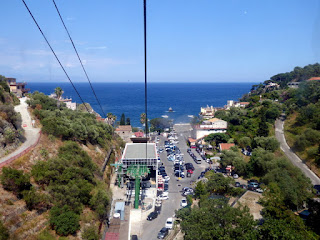 |
| Looking back to where we came from. |
 |
| Houses built on the steep hills |
 |
| The bay we left |
 |
Former castle, built in Norman style in 3 stages
at the main square. |
She showed us through the ruins it is famous for. Initially, there was a Greek theater in the 300s BCE, which was converted to a Roman amphitheater 600 years later. Although their purposes were different (plays in the Greek era vs. gladiators and wild animals in the Roman era), the Romans were somewhat limited by the geography of the place and couldn't easily expand it to the oval style like the Roman Coliseum. This meant it kept a more Greek shape with a lot of Roman embellishments. It has been restored a number of times -- all the red bricks are modern -- with the dual goal of giving it back its ancient shape AND creating a public performance space that is in use today. Vera says it is really special when you are at an evening performance and Mt. Etna, which this amphitheater faces, begins to erupt.
 |
| Approaching the theatre/arena |
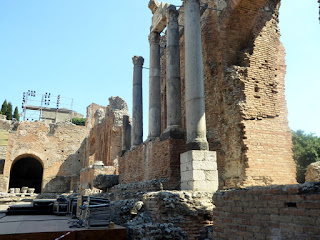 |
| Interior where the Romans added walls behind the Greek columns. |
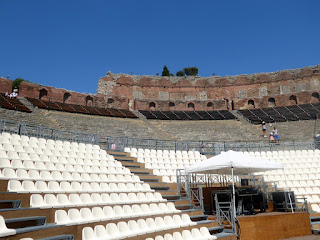 |
Seating from below. They were setting up for an event, and the
theater is used regularly. Above the stone steps are wooden
platforms for current use. |
 |
| Above and below: Killer views! |
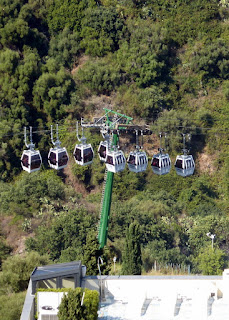 |
| Cable cars passing each other. |
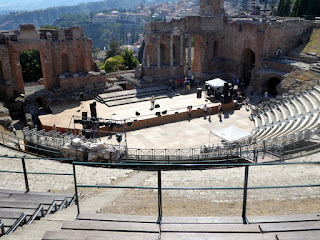 |
Above and two below: views of the theater seating area. Before
restoration, it all looked like the grassy area and was used for
grazing livestock. |
We were left with over an hour to explore the rest of the town before driving back to Catania and getting an enormous hamburger at a place called FUD (food) with Isabella.
 |
A seriously skinny street -- probably narrower
than the dinky one we saw a couple years ago
in Romania |
 |
"Middle Gate" -- in the middle of the city
between Catania Gate and Messina Gate. |
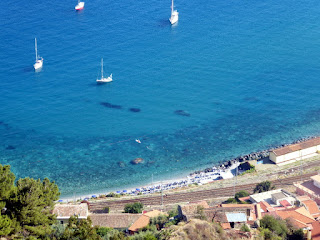 |
We have been consistently impressed with water clarity most
of the places we have seen. |
 |
There were two weddings while we were there.
This is one of the brides and her father, who is
holding onto a 4-year old flower girl on his left. |